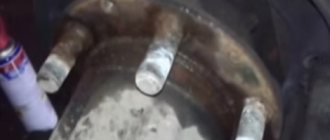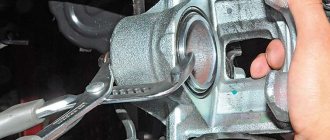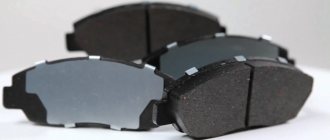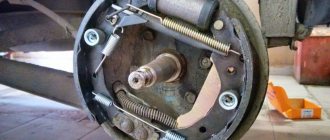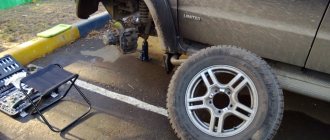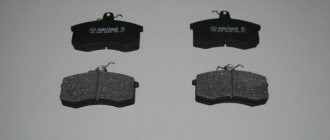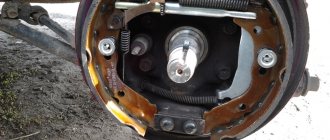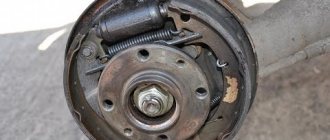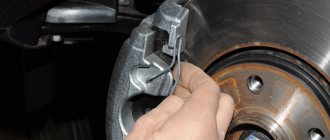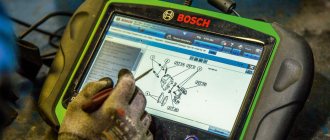Replacing rear wheel brake pads on a Chevrolet Cruze
In the relatively short time of its existence, the Chevrolet Cruze has gained wide popularity in the global car market.
The popularity of this vehicle model is evidenced by the fact that more than 3 million copies of different modifications of the Chevrolet Cruze have been sold worldwide. Despite its fairly high quality and reliability, like any other car, the Chevrolet Cruze requires periodic repairs and maintenance.
conclusions
This completes the replacement of the rear pads, good luck to everyone and strong brakes!
The following two tabs change content below.
His love for cars began in childhood, when he began collecting model cars. I always helped my father with the repair of an old penny, where he gained his first experience. Today I am the owner of a small car maintenance and repair service. I try to keep up with the times, studying new technologies for diagnosing modern cars.
Which rear pads should I choose to replace on a Cruze?
In different trim levels, the Chevrolet Cruze is equipped with different brake discs of sizes R15 and R16. The original part numbers for these two types are different, but the size of the rear pads is no different from each other, unlike the front ones.
- For Cruz with R15, rear pad part numbers: 13300867 and 13411380
- For R16 pads 13319294 or 13411383 are suitable
I repeat once again that the pads are the same size and will fit both types of brake discs. Not to be confused with the front pads, which are different in size.
Original pads are not cheap, but to replace them you can choose cheaper analogues at reasonable prices. The original General Motors 95516192 costs from 2500 rubles. set.
- Ashika 51-0W-W05 from 700 RUR
- Brembo P 59 080 from 2300 RUR
- Ferodo FDB 4265 from 2200 RUR
- Markon 43302162 from 600 RUR
- Sangsin Brake SP1363 from 1060 RUR
- UBS B1104012 from 900 rub.
When purchasing analogue pads, it is advisable to check in the catalog whether the pads are suitable for your car or not.
How to quickly and easily replace the front ones
- There is even less work with the front overlays. We only have to unscrew one bolt. It is located at the bottom of the caliper. Use a 13mm wrench, or a socket with a knob.
Remove the wheel
For better access, turn the wheel outward.
For ease of work, you can use a headlamp. So that later you don’t have to bother with pressing in the brake cylinder, you can do it right away, without removing the old pads. Insert the screwdriver inside and use it as a lever to push the cylinder in.
Press the piston into the cylinder
If this doesn’t work, then “open” the caliper upwards and take a larger lever (pry bar, wheel wrench).
If you do this in advance, the new pads will fit easier. With the top raised, you have direct access to the pads. Next we follow the procedure from the previous section. Remove the old trims and clips.
Remove the used pads and retainers
Afterwards, clean the installation site with a metal brush or a simple screwdriver.
After reinstallation, do not forget to clean the seats. Install new retaining plates and install new brake pads. Ceramic lubricant will not hurt on the front brake mechanism either (although in order to lubricate all the guides, you will have to unscrew the second bolt).
Close the caliper
Close the caliper and tighten the bottom bolt (remember to hold the guide).
Tighten the loosened bolts
How the front ones change: video
Possible complications
Disc brakes are quite easy to maintain and there are no special problems when working with them, but there are a couple of nuances:
- The brake cylinder does not press in. In this case, open the brake fluid reservoir cap to relieve pressure in the system.
- When you open the lid, it is advisable to pump out some of the liquid with a large syringe (at least 50–100 ml). When the cylinder is pressed in, the brake fluid may rise above the maximum mark and leak out of the reservoir.
- If you notice damage to any boot of the braking system, it must be replaced. The entry of a small amount of dust or dirt into the mechanism very quickly leads to failure of the element.
Read the instructions and reinforce the material by watching the video. With such preparation you will not have any difficulties with replacement. Follow all steps carefully and without haste. It is highly recommended not to skip the point of using ceramic lubricant. The monetary and time costs are minimal, but the beneficial effect is noticeable.
- Author: Vladimir
Rate this article:
- 5
- 4
- 3
- 2
- 1
(7 votes, average: 3.9 out of 5)
Share with your friends!
How to change rear brake pads
- To access the rear pads, you need to split the caliper into two parts. To do this, unscrew the fastening bolts (13 wrench). Hold the guides with a 18mm wrench. When turning, the boot may be damaged, so hold it firmly.
The arrows indicate the mounting bolts; they need to be removed. - Once unscrewed, remove the top of the caliper completely. Now you should remove the old pads. You may need the help of a flathead screwdriver (move to the side). Remove the old fixing plates along with the pads. They weaken over time and may not hold the pads well.
Remove old retaining plates - The Chevrolet Cruze has a “tricky” rear brake cylinder. You can't squeeze him that easily. You need an auxiliary tool in the form of pliers or a grinder key.
To continue, use the key from the grinder or passages
Turn it clockwise with pressure until it is level with the boot. Without this procedure, you will not be able to put the caliper back together due to the thicker new pads.
Turn clockwise until the boot is level
- There is a special protrusion in the central upper part of the block. It should line up with one of the holes on the brake cylinder. Pay attention to this when “scrolling” (the hole should be aligned with the center of the block). Be sure to clean the seat before installing new plates. New clamps usually come complete with pads.
Clean the pad seat from rust and debris - The following procedure is optional. It is not necessary to do this, but it is advisable. There is a special ceramic lubricant for brake mechanisms. It serves two purposes: preventing brake jamming;
- elimination of extraneous knocks.
see also
Comments 24
Hello! Please tell me. There is a groove on the caliper where the boot fits, or is it just tensioned and that’s it... And also, did you lubricate the pre-fitting on the caliper under the boot?
Good day, I didn’t lubricate anything, on the contrary, I cleaned everything thoroughly, there is no groove as such, it will be very difficult to put the boot in place!
Thank you, I ended up lubricating the seat and it still fit tightly, I hope it won’t come off due to the lubricant.
The boot fit very tightly, of course, it probably even seemed to hang on to the snot, but it didn’t fall off.
Let's hope that it won't come off for me, despite the presence of lubricant! Thank you.
Can you write in more detail about installing the boot? My front left outer pad was worn out and “lifted” the disc (it soured and did not come off). The wear of the remaining front pads is no more than 30% (approximately 27 thousand km). I had to change the discs and pads. I found a small hole on the boot on the right. Everything is clean under the dust cover. The caliper is working and does not leak. The boot seat on the cylinder is as clean as new. There is a hole in the outer fold of the boot and with slight wear on the pads (recessed piston), practically no dirt gets onto the piston. I decided to change only the boot without disconnecting the brake hose. I read reviews about repair kits and bought the same Frenkit - 260061. I disconnected the caliper from the bracket, put a 45 mm thick block in it and pressed the piston to the block with a pedal. I took off the old boot, cleaned everything, lubricated the piston and began installing a new boot. First I put it on the piston. Then, with the help of my fingers, a dull shoe knife and a screwdriver, I put it on the caliper with difficulty, but it seems to be completely, but it slides off. I do the same with the old (leaky) boot - it fits easier and holds well (you can’t remove it with your hands, you have to move it with a knife). As a result, I installed the old one for now. I don’t understand whether I’m doing something wrong, or whether the reason is in the boot. And as it turned out, one boot needs to be changed at the back. In general, I don’t know what to do.
Cruz 2011, F16D3 engine, 109 hp, sedan, mileage 120 thousand km.
Can you tell me the part number for the rear caliper repair kit?
I can’t tell you about the rear one! Search by name and I think you’ll find everything!
source
What are the best rear brake pads for a Chevrolet Cruze?
Before choosing the best (for a specific case, of course) rear pads for the Cruise, it is advisable to make sure that the brake system elements are in good working order.
Rear brake pads.
The durability of friction linings, noises and squeaks during braking, and performance can be affected not only by the pads themselves, but also by:
- condition of brake hydraulic lines and hoses;
- quality and condition of the rear caliper damper and retaining plates;
- density and tightness of cuffs, anthers;
- condition of the brake disc;
- elements for adjusting and distributing braking force.
Any of these malfunctions can lead to uneven wear on the rear pads on the Cruise, noise when the brakes are applied, and ineffective operation. You should start choosing new pads only after a complete diagnosis of the system.
Factory pads
branded pads with GM catalog number 13319294
From the factory, Chevrolet Cruze is equipped with branded GM rear pads with GM catalog number 13319294.
If we decide to trust only original pads, we need to be prepared to say goodbye to at least 3,500 rubles . A little expensive. Therefore, we will make a short review of non-original, but good rear pads for the Chevrolet Cruze.
We are looking for a replacement for the original rear pads on the Cruze
It's not just about price. Each set of pads gets its own unique properties thanks to the development of new friction materials. For example, expensive Otto Zimmermann rear pads are softer and less noisy. Their price is within 3 thousand, and the reviews about them are very flattering.
Cheaper
There are also cheaper pads:
- Korean Sangsin brake pads (can be sold under the HI-Q brand) with a price of about 1900 rubles per set. They are considered durable, but harsh. With an aggressive driving style, they will be quite suitable, they will last for 40-50 thousand, but a calm driver may be uncomfortable. When purchasing, we be sure to check the authenticity, since the brand is promoted and there are a lot of fakes.
Replacing Rear Brake Pads on a Chevrolet Cruze Video
Chevrolet Cruz brake pads: choose and change yourself
All Chevrolet Cruzes are equipped with ventilated disc brakes. The brake metering system includes brake pads, which are the main parts of the workpiece. they specifically manufacture brakes and, as a result, become unusable.
The unique brake pads on the Chevrolet Cruz manufactured by General Motors are made of high-quality anti-friction steel. However, no matter how unique the parts are, they are purchased from an official representative, and their price is approaching a high figure. After all, you can buy a good analogue yourself, without succumbing to unusual gaskets, and change it yourself. This is done if your car is not on lease, as the agreement with the various banks requires the full range of work to be created only on the official 100. It should also be noted that motorists often have their own pads, which cause complaints as they become useless after 15-20 thousand kilometers.
Brake pads for Chevrolet Cruze. what to choose?
Chevrolet Cruz brake pads are manufactured by General Motors and have part numbers 13301234 for the front pads and 13319294 for the rear pads. For unique Chevrolet Cruz brake pads, the cost is approximately 3200-3500 rubles.
Gaskets are also available from several companies. Below is information about the manufacturer that produces such parts, the average price of the product and, in addition, the operating features of the non-original lining. Because you can find out which brake pads are best for Chevrolet Cruze.
Analog models
Brake SANGSIN (HI-Q)
The largest manufacturer of brake pads in the region. As a result, the products of this Korean company and front brake pads for the Chevrolet Cruz are much cheaper than unique spare parts. For comparison, the cost of unique gaskets is approximately 3200-3500 rubles per set, although SANGSIN gaskets will cost 1100-1800 rubles depending on the type of model. There are two types of pads. SP1362 (HP1362 on rear brakes) SP-1363 (HP1363 on rear brakes). The products of this manufacturer are of the highest quality, and a set of gaskets lasts for 60–90 thousand kilometers, depending on driving style. However, you need to be careful. There are many fakes of this brand because they buy low-quality spare parts.
DELPHILP 2170
This is one of the cheapest shoes. The cost ranges from 800 to 1000 rubles. Naturally. Low quality. Pros include an increased braking area, unfortunately, despite this, the brake strip has a smooth surface without a pattern, which reduces braking properties.
2010 Chevrolet Cruze 1.6 Chevrolet Cruze Rear Brake Pads Replacement
Chevrolet Cruze 1.6 Chevrolet Cruze
2010
Rear Brake Pad Replacement
Thanks for the views and for.
Replace your Chevrolet Cruze rear pads!
How to change back
what is it called the windshield
pad
on
a Chevrolet Cruze
without the help of others!
ate
Excellent Polish pads that have improved braking properties and are even better in quality than the originals. They do not creak or gather dust, since fiberglass-based materials are used as coatings. At the same time, the cost of such pads is higher. For this reason, you can buy rear brake pads for Chevrolet Cruz, the manufacturer can easily get about 2000 rubles.
HANKOOK
Chevrolet Cruz uses FRIXA and FRIXAPremiumS1 pads. The cost of regular gaskets is 1100-1400 rubles, for the Premium model. 1800-2000 rubles. Judging by the reviews of car enthusiasts, the differences in unique details are not special, although there are no advantages either. The pads squeak, they are very dusty due to the high content of graphite and metal.
OEM number and price of original rear pads
Chevrolet Cruze with 1.6 and 1.8 liter engines is equipped with two types of wheels:
- 195/65/R15;
- 205/60/R16.
In the case of 15-inch wheels, brake discs with a diameter of 268 millimeters and a thickness of 12 mm are used. With larger wheels, the rim diameter is 292 mm.
The rear brake pads for the R15 and R16 do not differ in size, but despite this they have different article numbers. For wheels with a diameter of R15, pads with article numbers 13300867 or 13411380 are used. For R15, brake system elements with numbers 13319294 and 13411383 are used. Despite the fact that the article numbers are different, the original pads for cars with wheels 195/65/R15 and 205/60/R16 are interchangeable.
The cost of original products for the R16 ranges from 3,000 to 3,300 rubles. Brake pads for R15 have a slightly higher price. They can be purchased for 3500-4300 rubles.
2290-17-02-08
To do this, carefully, so as not to damage the piston boot and the plastic piston itself, use sliding pliers to recess the piston into the cylinder.
We assemble the brake mechanism in reverse order. When installing the inner pad, it must be oriented so that the acoustic wear indicator is located at the top of the pad. We tighten the bolts securing the caliper to the guide pins to a torque of 28 Nm. After replacing the pads in the brake mechanisms of both front wheels, press the brake pedal several times to set the gaps between the pads and discs. We check the level of working fluid in the hydraulic reservoir of the brakes and clutch and, if necessary, bring it to normal.
[We save on Chevrolet Cruze maintenance] [Chevrolet Cruze maintenance at 15 thousand km] [Chevrolet Cruze maintenance at 30 thousand km] [Chevrolet Cruze maintenance at 45 thousand km] [Chevrolet Cruze maintenance at 60 thousand km] [Chevrolet Cruze maintenance at 90 thousand km] [Chevrolet Cruze maintenance at 150 thousand km] [Chevrolet Cruze maintenance at 180 thousand km] [Tools required for maintenance Chevrolet Cruze] [Carrying out maintenance yourself - general recommendations] [Safety rules for doing car maintenance yourself]
Replacing brake pads for the front wheels of a Chevrolet Cruze
Chevrolet Cruze › Logbook › Repairing a jammed caliper.
Hello everyone. I recently wrote about the problem. While driving, the brake discs and pads began to whistle; when I pressed the brakes, the whistle disappeared, then started again. I found out what the reason was, the caliper piston was jammed. For resuscitation it was necessary: Repair kit bought Frenkit catalog number 260061 - 300 rubles.
We replace the brake fluid with the engine not running, first in one circuit and then in the other in the following sequence:
right rear wheel brake; left front wheel brake mechanism; left rear wheel brake; brake mechanism of the right front wheel.
A 10 mm spanner, a tube and a bottle are used.
Since my front left wheel hurt, I first pumped up the rear right one and only then began to deal with the caliper.
